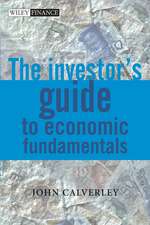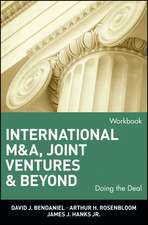Practical Portfolio Performance Measurement and Attribution, 3rd Edition
Autor CR Baconen Limba Engleză Hardback – 25 ian 2023
Preț: 491.59 lei
Preț vechi: 614.49 lei
-20% Nou
Puncte Express: 737
Preț estimativ în valută:
94.09€ • 97.86$ • 78.85£
94.09€ • 97.86$ • 78.85£
Carte disponibilă
Livrare economică 20 februarie-06 martie
Livrare express 05-11 februarie pentru 38.09 lei
Preluare comenzi: 021 569.72.76
Specificații
ISBN-13: 9781119831945
ISBN-10: 1119831946
Pagini: 560
Dimensiuni: 178 x 264 x 37 mm
Greutate: 0.68 kg
Ediția:3rd Edition
Editura: Wiley
Locul publicării:Chichester, United Kingdom
ISBN-10: 1119831946
Pagini: 560
Dimensiuni: 178 x 264 x 37 mm
Greutate: 0.68 kg
Ediția:3rd Edition
Editura: Wiley
Locul publicării:Chichester, United Kingdom
Cuprins
Contents
Acknowledgements
Contents
Chapter 1 Introduction
The Performance Measurement Process
Role of performance analysts
Book Structure
Chapter 2 The Asset Management Industry
Asset Classes
Public Equities
Bonds (or Fixed Income)
Cash (and near cash)
Private Assets
Real Estate
Private Equity
Private Debt
Infrastructure
Natural Resources
Commodities
Derivatives
Futures
Forwards
Swaps
Contracts for Difference (CFD)
Options
Overlay Strategies
Currency
Hedge Funds
Asset Allocation
Strategic asset allocation
Tactical asset allocation.
Chapter 3 The Mathematics of Portfolio Return
Simple Return
Continuously Compounded (or logarithmic) Returns
Money-weighted Returns (MWR)
Internal Rate of Return (IRR)
Ex-ante Internal Rate of Return
Simple Internal Rate of Return
Ex-post Internal Rate of Return
Simple Dietz
ICAA Method
Modified Dietz
Time-Weighted Returns (TWR)
True Time-Weighted
Unit Price Method
Unit Price Method with Distributions
Time-weighted versus Money-weighted Rates of Return
Approximations to the Time Weighted Return
Index Substitution
Regression Method (or b method)
Analyst's Test
Hybrid Methodologies
Linked Modified Dietz
BAI Method (or linked IRR)
Which method to use?
Late Trading and Market Timing
Self-selection
Large Cash Flow
Self-selection of methodologies
Annualised Returns
Since Inception Internal Rate of Return (SI-IRR)
Modified IRR (MIRR)
Return Hiatus
Gross and net of fee calculations
Estimating gross and net of fee returns
Initial Fees
Performance Fees
Asymmetric or Symmetric
Crystallisation
Performance Fees in Practice
Equalization
Reporting Hierarchy
Overlay Strategies
Overlay performance return calculations:
Base currency and local returns
Currency conversions
Hedged Returns
Currency Overlay Returns
Perfectly Hedged Returns
Portfolio Component Returns
Money-weighted Component Returns
End of day
Beginning of day
Intra-day weighted
Differentiated
Actual Time
Rule-based
Extremely large cash flows
Which timing assumption to use for time-weighted returns?
Carve Outs
Sub-portfolios
Cash Sectors
Individual security returns
Multi-period component returns
Abnormal Returns
Short Positions
Contribution to return
Composite returns
Chapter 4 Benchmarks
Benchmarks
Benchmark attributes
The Role of Benchmarks
Types of Benchmarks
Commercial Indexes
Calculation methodologies
Aggregate Price Index (Price-weighted Index or Carli type)
Geometric (or Jevons type) Index
Market Capitalisation Index
Laspeyres Index
Paasche Index
Marshall - Edgeworth Index
Fisher Index
Equal weighted Indexes
Fundamental Indexes
Optimised Indexes (efficient or minimum variance indexes)
Fixed Income Indexes
Index Providers
Choice of Index Provider
Benchmark Regulation
Choice of Index
Currency Effects in Benchmark
Hedged Indexes
Customised Indexes
Capped Indexes
Peer Groups and Universes
Percentile Rank
Random Portfolios
Exchange Traded Funds (ETFs)
Target Returns
Blended Benchmarks (or balanced benchmarks)
Fixed Weight & Dynamised Benchmarks
Spliced Indexes
Money-weighted Benchmarks (or public market equivalents)
Normal Portfolio
Benchmark Statistics
Index Turnover
Up-capture Indicator
Down-capture Indicator
Up-number Ratio
Down-number Ratio
Up-percentage Ratio
Down-percentage Ratio
Percentage Gain Ratio
Excess return
Arithmetic Excess Return
Geometric Excess Return
Chapter 5 Risk
Definition of Risk
Risk types
Risk management v Risk control
Risk aversion
Ex-post and ex-ante
Descriptive Statistics
Mean (or arithmetic mean)
Mean absolute deviation (or mean deviation)
Variance
Bessel's correction (population or sample, n or n-1)
Sample variance
Standard deviation (variability or volatility)
Annualised risk (or time aggregation)
The Central Limit Theorem
Frequency and number of data points
Normal (or Gaussian) distribution
Histograms
Skewness (Fisher's or moment skewness)
Sample skewness
Kurtosis (Pearson's kurtosis)
Excess kurtosis (or Fisher's kurtosis)
Sample kurtosis
Bera-Jarque statistic (or Jarque-Bera)
Covariance
Sample covariance
Correlation (r)
Sample correlation
Performance appraisal
Sharpe ratio (reward to variability, Sharpe index)
Roy ratio
Risk-free rate
Alternative Sharpe ratio
Revised Sharpe ratio
Adjusted Sharpe Ratio
Skew-adjusted Sharpe Ratio
Relative risk
Tracking error (or tracking risk, relative risk, active risk)
Information ratio
Geometric information ratio
Modified information ratio
Regression analysis
Regression equation
Regression alpha
Regression beta
Regression epsilon
Capital Asset Pricing Model (CAPM)
Beta (b) (systematic risk or volatility)
Jensen's alpha (Jensen's measure or Jensen's differential return or ex-post alpha)
Annualised alpha
Bull beta (b+)
Bear beta (b-)
Beta timing ratio
Market timing
Systematic risk
Correlation
R²(or coefficient of determination)
Specific (or residual) risk
Treynor ratio (Reward to volatility)
Appraisal ratio (or Treynor-Black ratio)
Factor Models
Fama decomposition
Selectivity
Diversification
Net selectivity
Fama-French three factor model
Three factor alpha (or Fama-French alpha)
Carhart four factor model
Four factor alpha (or Carhart's alpha)
Multi-factor Models
Drawdown
Average drawdown
Maximum drawdown
Largest individual drawdown
Recovery time (or drawdown duration)
Drawdown deviation
Ulcer index
Pain index
Calmar ratio (or Drawdown ratio)
MAR ratio
Sterling ratio
Sterling-Calmar ratio
Burke ratio
Modified Burke ratio
Martin ratio (or Ulcer performance index)
Pain ratio
Partial Moments
Downside risk (or semi-standard deviation)
Downside potential
Pure downside risk
Half variance (or semi-variance)
Upside risk (or upside uncertainty)
Mean absolute moment
Omega ratio (W)
Bernardo & Ledoit (or gain-loss) ratio
d ratio
Omega-Sharpe ratio
Sortino ratio
Reward to half-variance
Downside risk Sharpe ratio
Sortino-Satchell ratio
Kappa ratio
Upside potential ratio
Volatility skewness
Variability skewness
Farinelli-Tibiletti Ratio
Prospect ratio
Fixed Income Risk
Pricing fixed income instruments
Redemption yield (yield to maturity)
Weighted average cash flow
Duration (effective mean term, discounted mean term or volatility)
Macaulay duration
Macaulay-Weil duration
Modified duration
Portfolio duration
Effective duration (or option-adjusted duration)
Duration to worst
Convexity
Modified convexity
Effective convexity
Portfolio convexity
Bond returns
Duration beta
Reward to duration
Miscellaneous Risk Measures
Hurst index (or Hurst exponent)
Bias ratio
Active Share
Value at Risk (VaR)
Risk-adjusted return
M²
M² excess return
Differential return
Adjusted M²
Skew-adjusted M²
Types of Excess Return (or Alpha)
A Periodic Table of Risk Measures
Periodic Table Design
Why measure ex-post risk?
Which risk measures to use?
Hedge funds
Smoothing
Outliers
Data mining
Time Period
Chapter 6 Return Attribution 280
What is Attribution?
Definition
Attribution as an asset management tool
Early Development
Types of Return Attribution
Returns-based (regression or factor) Attribution
Holdings-based (or buy/hold) Attribution
Transaction-based Attribution
Arithmetic Attribution
Brinson, Hood & Beebower
Asset Allocation
Security (or Stock) Selection
Interaction
Brinson & Fachler
Interaction
Geometric Excess Return Attribution
Asset allocation
Stock selection
Sector Weights
Frequency of Analysis
Security Level Attribution
Transaction costs
Off-benchmark (or zero weight sector) attribution
Attribution consistent with the Investment Decision Process
Market Neutral Attribution
Attribution for 130/30 funds (or extended short funds)
Leverage (or gearing)
Attribution including derivatives
Attribution including Equity Index Futures
Attribution Analysis using options
Multi-currency attribution
Ankrim & Hensel
Karnosky & Singer
Geometric Multi-Currency Attribution
Naïve Currency Attribution
Compounding effects
Geometric Currency Allocation
Currency Timing
Interest Rate Differentials
Revised Currency Allocation
Revised Country Allocation
Incorporating Forward Currency Contracts
Summarising
Other Currency Issues
Fixed Income Attribution
The Yield Curve
Yield curve analysis
Shift
Twist (or slope)
Curvature (or butterfly)
Carry
Credit (or spread)
Yield Curve Decomposition
Wagner & Tito
Weighted Duration Attribution
Geometric Fixed Income Attribution
Campisi Framework
Yield Curve Decomposition
Multi-period attribution
Smoothing Algorithms
Carino
Menchero
Linking Algorithms
GRAP Method
Frongello
Davies & Laker
Multi-period Geometric Attribution
Annualisation of Excess Return
Attribution Annualisation
Contribution Analysis (or absolute return attribution)
Risk-adjusted Attribution
Selectivity
Multi-level Attribution
Balanced attribution
Evolution of performance attribution methodologies
Chapter 7 Performance Presentation Standards
Why do we need performance presentation standards?
Global Investment Performance Standards (GIPS(r)) - A history
Advantages for Asset Managers
The GIPS Standards
Fundamentals of Compliance
Definition of the Firm
Maintaining Policies and Procedures
Providing GIPS Reports
Benchmark Selection
Correcting Errors in GIPS Reports
Composite Descriptions
Recordkeeping
Linking of theoretical and actual performance
Portability
Use of time-weighted or money-weighted returns
Claiming Compliance with the GIPS standards.
Input Data and Calculation Methodology
Firm Assets, Composite Assets and Pooled Fund Assets
Overlay Exposure
Returns
Valuation
Time-Weighted Returns
Money-weighted Returns
Net Returns
Composite Returns
Private Market Investments
Real Estate
Net-of-fee Carve-outs returns
Wrap fee, side pockets and subscription lines of credit
Composite and Pooled Fund Maintenance
Composite Maintenance
Carve-Outs
Presentation and Reporting
Composite Time-weighted Return Report
Returns, Dispersion & Risk
Unobservable inputs, gross or net-of-fees, multiple benchmarks, breaks in performance, carve-outs and non-fee-paying portfolios
Committed Capital and Advisory Assets
Reporting currency, carve-outs, overlay strategies, wrap fees and supplemental information
Composite Money-weighted Reports
Composite Cumulative Committed Capital
Total Value to Since-inception Paid in Capital (TVPI or Multiple of Investment Capital (MOIC) or Investment Multiple)
Since-inception Distributions to Since-inception Paid-in Capital (Realisation multiple or DPI)
Since-inception Paid-in Capital to cumulative Committed Capital (PIC Multiple)
Residual Value to since-Inception Paid-in Capital (Unrealised Multiple or RVPI)
Disclosures
Claim of Compliance
Firm, composite and benchmark definitions
Fee disclosures
Inception date, creation date, composite lists availability of policies and procedures, leverage and estimated transaction costs.
Significant events, redefinition, minimum asset levels and withholding tax
Conflicts with regulation, carve-out disclosures & sub-advisors.
Benchmark Disclosures
Significant cash flow disclosure and material errors.
Risk measures, overlay strategy, real estate valuation and theoretical performance disclosures.
Sample GIPS Composite Report
GIPS Advertising Guidelines
Fundamental requirements of the GIPS Advertising Guidelines
GIPS Advertisements that do not include performance.
GIPS advertisements for composites
GIPS Advertisements for a Broad Distribution Pooled Fund
Verification
Performance Examination
Achieving Compliance
Maintaining Compliance
GIPS Standards for Asset Owners
Chapter 8 Bringing it all together
Effective dashboards
Data visualisation tools
Manager Selection
Asset Manager Selection
Manager Evaluation
Portfolio Evaluation
Monitoring and Control
The Four Dimensions of Performance
Ex-post Return (The traditional dimension)
Ex-post Risk (The neglected dimension)
Ex-ante Return (The unknown dimension)
Ex-ante Risk (The "sexy" dimension)
Risk efficiency ratio
Performance efficiency
Risk control structure
Risk management
Glossary of Key Terms
Appendix A - Simple Attribution
Appendix B - Multi-Currency Attribution Methodology
Bibliography
Index
Notă biografică
CARL R. BACON, CIPM, is Chief Advisor to Confluence. He is a member of the Advisory Board of the Journal of Performance Measurement and Founder of The Freedom Index Company. He is the former Chairman of StatPro plc, Director of Risk Control and Performance at Foreign & Colonial Management Ltd and Vice President Head of Performance (Europe) for JP Morgan Investment Management Inc.




























